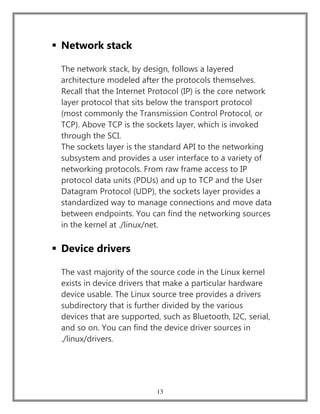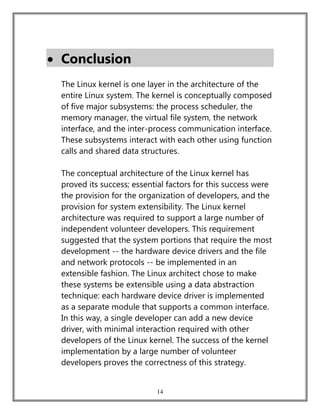This document discusses the key components and architecture of the Linux kernel. It begins by defining the kernel as the central module of an operating system that loads first and remains in memory, providing essential services. It then describes the major subsystems of Linux, including process management, memory management, virtual file systems, network stacks, and device drivers. It concludes that the modular design of the Linux kernel has supported its growth and success through independent and extensible development of these subsystems.
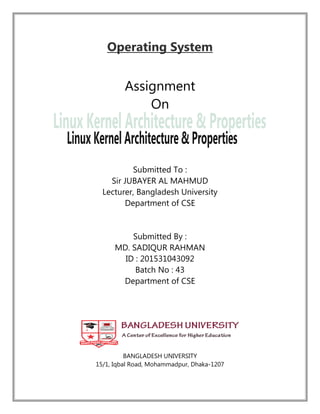

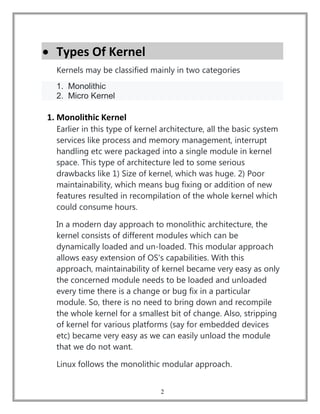
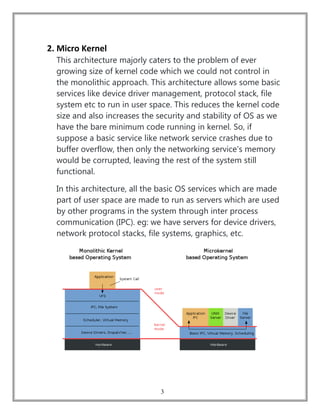


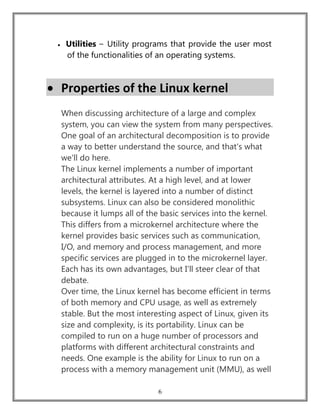
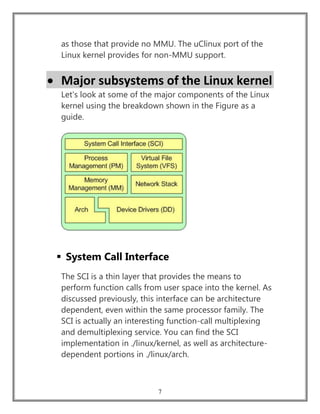
![8
Process Management
Process management is focused on the execution of
processes. In the kernel, these are called threads and
represent an individual virtualization of the processor
(thread code, data, stack, and CPU registers). In user
space, the term process is typically used, though the
Linux implementation does not separate the two
concepts (processes and threads). The kernel provides an
application program interface (API) through the SCI to
create a new process (fork, exec, or Portable Operating
System Interface [POSIX] functions), stop a process (kill,
exit), and communicate and synchronize between them
(signal, or POSIX mechanisms).
Also in process management is the need to share the
CPU between the active threads. The kernel implements
a novel scheduling algorithm that operates in constant
time, regardless of the number of threads vying for the
CPU. This is called the O(1) scheduler, denoting that the
same amount of time is taken to schedule one thread as
it is to schedule many. The O(1) scheduler also supports
multiple processors (called Symmetric MultiProcessing,
or SMP). You can find the process management sources
in ./linux/kernel and architecture-dependent sources in
./linux/arch).](https://image.slidesharecdn.com/linuxkernel-190912163049/85/Linux-kernel-Architecture-and-Properties-9-320.jpg)
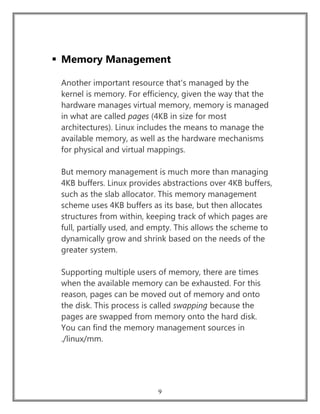
![10
File Systems
The term filesystem has two somewhat different
meanings, both of which are commonly used. This can be
confusing to novices, but after a while the meaning is
usually clear from the context.
One meaning is the entire hierarchy of directories (also
referred to as the directory tree) that is used to organize
files on a computer system. On Linux and Unix, the
directories start with the root directory (designated by a
forward slash), which contains a series of subdirectories,
each of which, in turn, contains further subdirectories,
etc.
A variant of this definition is the part of the entire
hierarchy of directories or of the directory tree that is
located on a single partition or disk. (A partition is a
section of a hard disk that contains a single type of
filesystem.)
The second meaning is the type of filesystem, that is,
]how the storage of data (i.e., files, folders, etc.) is
organized on a computer disk (hard disk, floppy disk,
CDROM, etc.) or on a partition on a hard disk. Each type
of filesystem has its own set of rules for controlling the
allocation of disk space to files and for associating data
about each file (referred to as meta data) with that file,](https://image.slidesharecdn.com/linuxkernel-190912163049/85/Linux-kernel-Architecture-and-Properties-11-320.jpg)
![11
such as its filename, the directory in which it is located,
its permissions and its creation date.
An example of a sentence using the word filesystem in
the first sense is: "Alice installed Linux with the filesystem
spread over two hard disks rather than on a single hard
disk." This refers to the fact that [ the entire hierarchy of
directories of ] Linux can be installed on a single disk or
spread over multiple disks, including disks on different
computers (or even disks on computers at different
locations).
An example of a sentence using the second meaning is:
"Bob installed Linux using only the ext3 filesystem
instead of using both the ext2 and ext3 filesystems." This
refers to the fact that a single Linux installation can
contain one or multiple types of filesystems. One hard
disk can contain one or multiple types of filesystems
(each z can be spread across multiple hard disks.
Virtual file system
The virtual file system (VFS) is an interesting aspect of the
Linux kernel because it provides a common interface
abstraction for file systems. The VFS provides a switching
layer between the SCI and the file systems supported by
the kernel (see the Figure).](https://image.slidesharecdn.com/linuxkernel-190912163049/85/Linux-kernel-Architecture-and-Properties-12-320.jpg)

